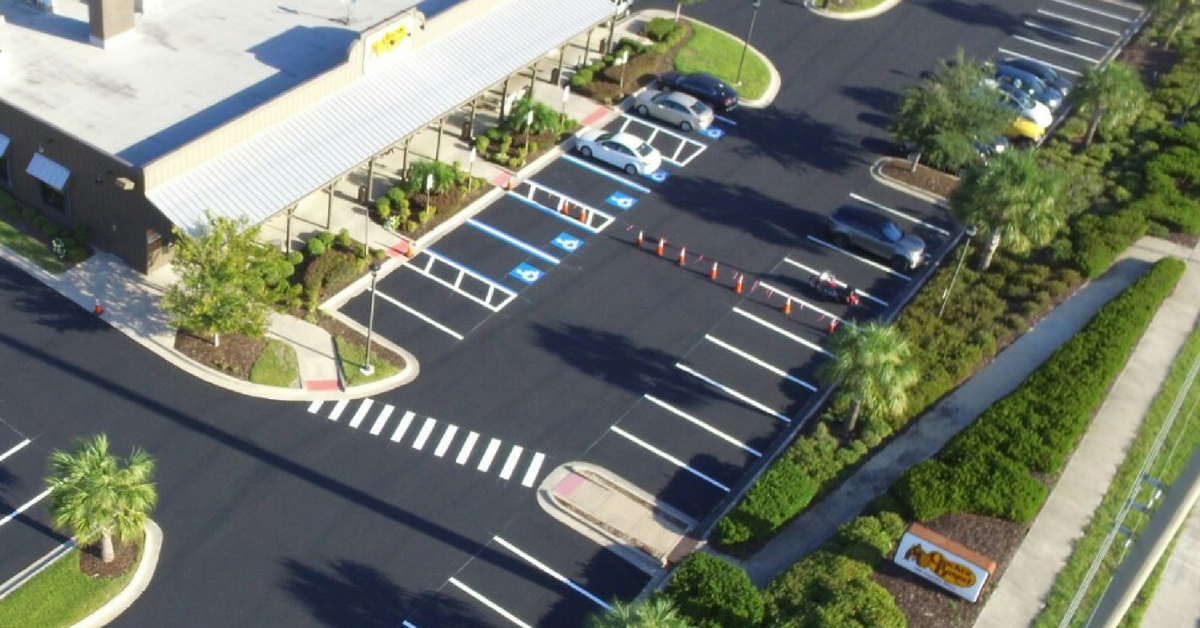Manage Risk with Proactive Paving
Updated on 11/4/2024

Everything you need to know about paving and risk management.
Expanding on the topic of “paving and risk management” involves understanding that a well-maintained parking lot or walkway does much more than provide a functional surface for vehicles and pedestrians. It also minimizes legal liability, enhances property value, and safeguards against potential costly lawsuits. Let’s delve deeper into how paving services play a pivotal role in comprehensive risk management and why property managers should prioritize this as an essential part of their maintenance strategy.
The Role of Paving in Risk Management
When it comes to managing a property, one of the most overlooked aspects of risk management is the state of the pavement. While interior maintenance and safety protocols are commonly prioritized, parking lots, pathways, and sidewalks are just as important. These are the first areas visitors, customers, and employees encounter, making them essential to creating a safe and welcoming environment. Cracks, potholes, faded markings, and other signs of wear not only detract from curb appeal but also pose serious safety risks. Paving and risk management, therefore, go hand-in-hand in promoting a secure and attractive property.
Pavement flaws can become trip hazards, lead to vehicle damage, or even cause severe accidents in extreme cases. Each of these incidents has the potential to lead to liability claims against the property owner, resulting in higher insurance premiums and possible legal disputes. Implementing a paving and risk management strategy reduces these risks by focusing on both preventive measures and prompt responses to damage.
Key Elements of Paving and Risk Management
An effective paving and risk management strategy involves several crucial steps:
- Regular Inspections: Schedule routine inspections to identify areas that need attention. Look for cracks, potholes, uneven surfaces, and other hazards. Some of these issues may seem minor at first, but they can escalate into significant risks if left unaddressed. Regular inspections allow you to catch problems early, addressing them before they become more severe and costly.
- Documentation and Planning: Document every inspection and maintenance activity. This record-keeping can provide valuable information for future maintenance planning and act as proof that proactive steps were taken in case of an accident or insurance claim. An organized documentation system also helps property managers budget for necessary repairs, ensuring funds are available when needed.
- Routine Maintenance: Routine maintenance is essential to prevent minor damage from turning into major hazards. Services like crack sealing, patching, and sealcoating help maintain the pavement’s integrity and extend its lifespan. These treatments protect the pavement from the elements, preventing further damage and maintaining a safer environment for pedestrians and drivers alike.
- Employee and Visitor Safety: Clear communication about potential hazards and repairs in progress is essential to a comprehensive paving and risk management approach. Signage indicating areas under repair or identifying known trip hazards until they’re addressed can prevent accidents. Establishing safety protocols for employees and communicating the importance of staying aware of changes in the parking lot or sidewalks enhances the overall safety culture on your property.
- Prioritize High-Traffic Areas: Pay special attention to areas with high foot or vehicle traffic. Entrances, exits, crosswalks, and accessible parking spots are critical areas that should be regularly inspected and prioritized for maintenance. These areas are often the first points of contact for visitors, making it essential to ensure they’re safe, clearly marked, and free from any hazards.
How Preventive Maintenance Saves You Money
Paving and risk management aren’t just about safety—they’re also financially savvy strategies. By investing in preventive maintenance, property managers can avoid the high costs associated with emergency repairs, potential lawsuits, and insurance hikes. For instance, fixing a small crack early on is far more affordable than dealing with an expanded pothole or widespread damage from water infiltration. Preventive measures like sealcoating, patching, and resurfacing preserve the pavement’s condition and extend its life, saving money over time.
Moreover, proactive paving maintenance supports better insurance outcomes. Insurance providers often evaluate properties based on their safety standards, and properties with regular maintenance schedules and well-kept lots may qualify for lower premiums. This can be a significant financial benefit, making routine paving maintenance a smart business decision.
Specialized Services for Paving and Risk Management
When selecting a paving company, it’s important to work with one that understands the complexities of risk management. Rose Paving offers a comprehensive suite of services designed to keep your property safe, functional, and visually appealing. Here’s how each of these services contributes to a holistic approach to risk management:
- Cracksealing: Cracks are the first indicators of potential pavement deterioration. Our cracksealing service fills these small breaks before they expand, protecting your lot from water damage and future cracks.
- Infrared Asphalt Repair: This technique is ideal for addressing localized damage without disrupting the entire pavement. It’s a cost-effective and fast way to repair high-risk areas, ensuring your lot remains safe for use.
- Pavement Marking: Clear, visible markings reduce confusion and guide traffic flow, preventing accidents. Markings for pedestrian crossings, directional arrows, and parking stalls also improve accessibility, reducing liability risks.
- Sealcoating and Resurfacing: Sealcoating provides a protective layer that shields the pavement from harsh weather, chemicals, and heavy traffic. Meanwhile, resurfacing restores your pavement’s integrity by adding a new layer on top of existing asphalt, offering a fresh start for heavily worn areas.
- Concrete Repair: From sidewalks to curbs, concrete repair services address the areas that often receive the most foot traffic. Concrete repair not only removes trip hazards but also contributes to the overall aesthetic and safety of the property.
Risk Management through a Partnership with Rose Paving
One of the most effective ways to approach paving and risk management is by partnering with an experienced provider like Rose Paving. We understand the unique needs of property managers, building owners, and businesses, offering tailored maintenance plans to suit each client’s needs. Our team helps you create a pavement management plan (PMP) that focuses on long-term safety and cost-effectiveness, enabling you to address risks before they become liabilities.
At Rose Paving, our commitment goes beyond basic repairs. We work with you to develop a strategic plan that keeps your pavement in optimal condition year-round. Our experienced team can assess your property, recommend services, and implement a proactive maintenance schedule to minimize risks, improve safety, and reduce costs.
Take control of your paving and risk management strategy today. Partnering with Rose Paving ensures your parking lot remains safe, well-maintained, and ready to serve your property’s needs. Reach out to us now to learn more about our paving and maintenance solutions. Contact Rose Paving today to discuss a paving management plan tailored to your needs and get a free consultation.




